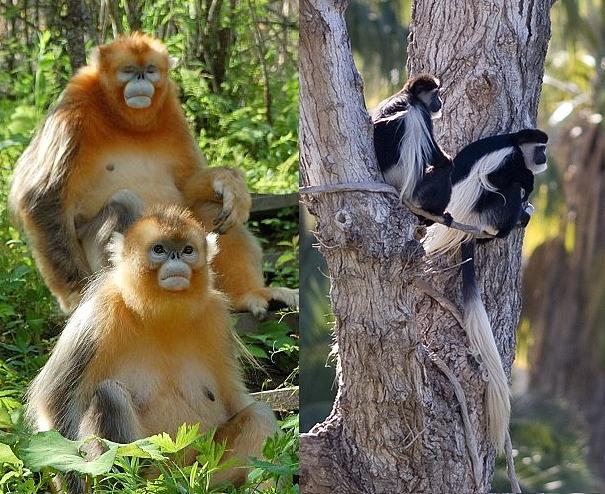Characteristics
New World monkeys are small to mid-sized primates, ranging from the pygmy marmoset (the world's smallest monkey), at 14 to 16 cm (5.5 to 6.3 in) and a weight of 120 to 190 grams (4.2 to 6.7 oz), to the southern muriqui, at 55 to 70 cm (22 to 28 in) and a weight of 12 to 15 kg (26 to 33 lb). New World monkeys differ slightly from Old World monkeys in several aspects. The most prominent phenotypic distinction is the nose, which is the feature used most commonly to distinguish between the two groups. The clade for the New World monkeys, Platyrrhini, means "flat nosed". The noses of New World monkeys are flatter than the narrow noses of the Old World monkeys, and have side-facing nostrils. New World monkeys are the only monkeys with prehensile tails—in comparison with the shorter, non-grasping tails of the anthropoids of the Old World.New World monkeys (except for the howler monkeys of genus Alouatta)[4] also typically lack the trichromatic vision of Old World monkeys.[5] Colour vision in New World primates relies on a single gene on the X-chromosome to produce pigments that absorb medium and long wavelength light, which contrasts with short wavelength light. As a result, males rely on a single medium/long pigment gene and are dichromatic, as are homozygous females. Heterozygous females may possess two alleles with different sensitivities within this range, and so can display trichromatic vision.[6]
Platyrrhines also differ from Old World monkeys in that they have twelve premolars instead of eight; having a dental formula of 2.1.3.32.1.3.3 or 2.1.3.22.1.3.2 (consisting of 2 incisors, 1 canine, 3 premolars, and 2 or 3 molars). This is in contrast with Old World Anthropoids, including gorillas, chimps, bonobos, siamangs, gibbons, orangutans, and most humans, which share a dental formula of 2.1.2.32.1.2.3. New World monkeys in the family Atelidae are the only primates with tails that are prehensile. Many New World monkeys are small and almost all are arboreal, so knowledge of them is less comprehensive than that of the more easily observed Old World monkeys. Unlike most Old World monkeys, many New World monkeys form monogamous pair bonds, and show substantial paternal care of young.[7] They eat fruits, nuts, insects, flowers, bird eggs, spiders, and small mammals. Unlike humans and most Old World monkeys, their thumbs are not opposable[8] (except for some Cebids).
Origin

About 40 million y Simiiformes infraorder split into the parvorders Platyrrhini (New World monkeys—in South America) and Catarrhini (apes and Old World monkeys—in Africa).[9] The individuals whose descendents would become Platyrrhini are currently conjectured to have migrated to South America either on a raft of vegetation or via a land bridge. There are two possible rafting routes, either across the Atlantic Ocean from Africa or across the Caribbean from North America. However, there is no fossil record to support the hypothesis of a migration from North America. The land bridge hypothesis relies on the existence of Atlantic Ocean ridges and a fall in the sea level in the Oligocene. This would have either produced a single land bridge or a series of mid-Atlantic islands to act as stepping stones for the migration. The later is now the favorite choice.[10]
At the time the new world monkeys split off, the Isthmus of Panama had not yet formed, ocean currents and climate were quite different, and the Atlantic Ocean was less than the present 2,800 km (1,700 mi) width by about a third; possibly 1,000 km less, based on the current estimate of the Atlantic mid-ocean ridge formation processes spreading rate of 25 mm/year.[citation needed]
Evolution

The chromosomal content of the ancestor species appears to have been 2n = 54.[11] In extant species, the 2n value varies from 16 in the titi monkey to 62 in the woolly monkey.
A Bayesian estimate of the most recent common ancestor of the extant species has a 95% confidence interval of 27 million years ago-31 million years ago.[12]
Classification
The following is the listing of the various platyrrhine families, and their placement in the Order Primates:[1][2]ORDER PRIMATES


No comments:
Post a Comment
Note: Only a member of this blog may post a comment.